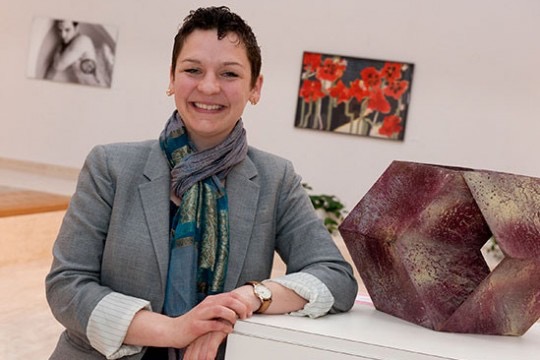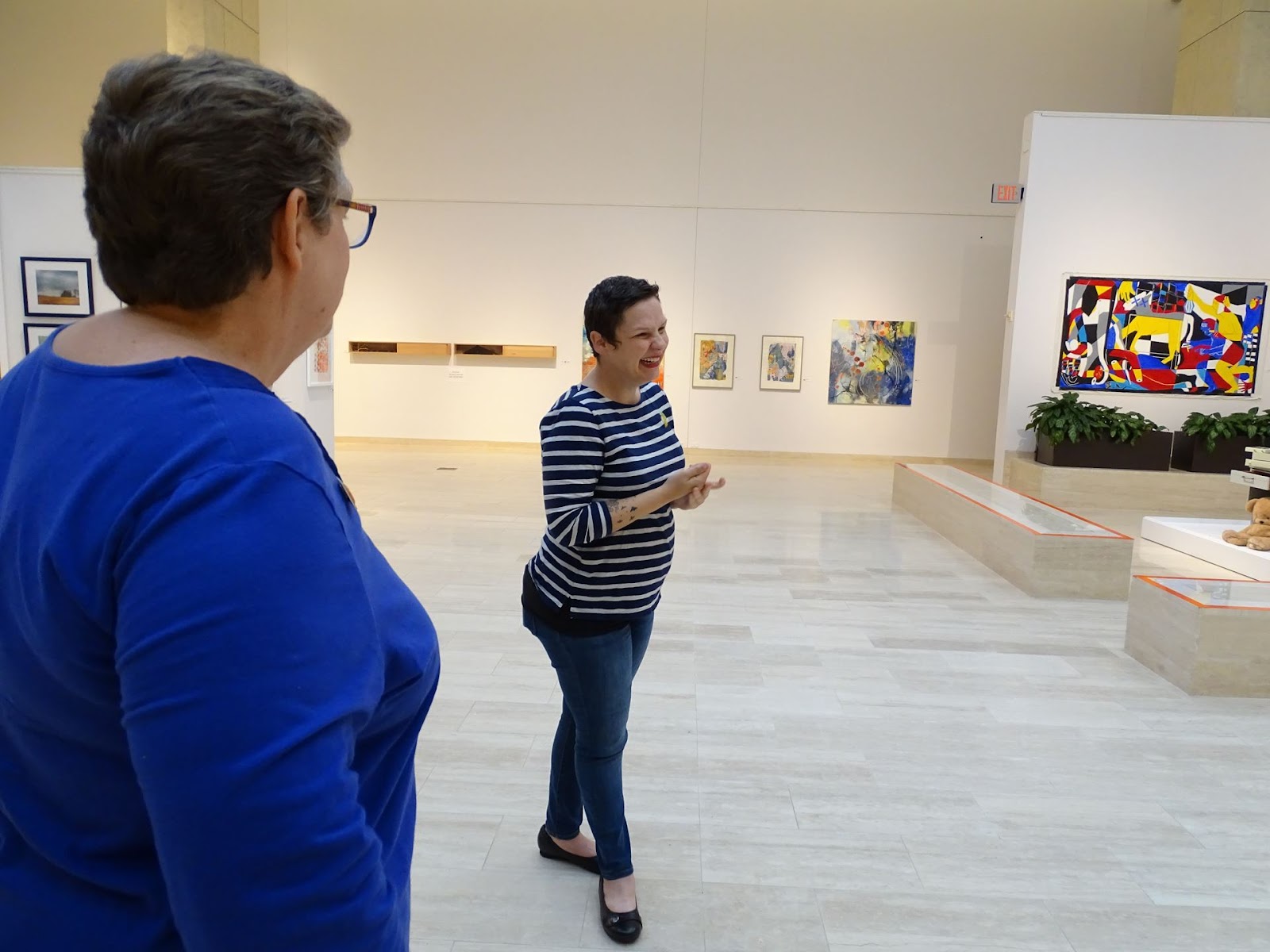Museums have changed their visitor expectations to reopen safely under NYS guidelines. Under these new guidelines, it is even more important to include access and resources for people with disabilities to reopen as inclusive as possible. July marks the 30th anniversary of the Americans with Disabilities Act. In commemoration of this important anniversary we are grateful to Tabitha Jacques, Director for the Dyer Arts Center at the National Technical Institute for the Deaf who shared important insight on how museums can accommodate people with disabilities as part of their reopening strategies.

Tabitha Jacques, Director for the Dyer Arts Center at the National Technical Institute for the Deaf
Remain Creative
“I think it’s important during these times to be very creative and somewhat flexible,” said Jacques. “COVID-19 precautions are so important, but it also takes away many things such as emotional connection (like a smile) or being able to touch or feel things.” While “Reopen New York” guidelines are critical for museums to follow as they reopen safely for staff and visitors, these same precautions can be harder for people with disabilities. “This is especially harder because on top of a world that is not universally designed, they [people with disabilities] have to deal with even more barriers due to safety protocols,” said Jacques. However, with the challenges that this pandemic creates for museums, it also presents an opportunity for museums to be creative while accommodating people with disabilities.
“There’s a good opportunity right now to be creative in opening doors to specific groups at specific times (such as Deaf/Blind visitors), providing the option to pay for their tickets online, and to make sure as much information is available online.”

Tabitha Jacques leads a tour in the Dyer Arts Center
Eliminating Barriers
Whether in person or virtual programming, there are certain barriers for people with disabilities that can deter their visit or from engaging with that museum at all. Videos that are not captioned are immediately inaccessible for deaf or hard of hearing people. “Or if there’s audio tours everywhere, but no printed labels,” said Jacques. “I enjoy learning, and I want to feel welcomed and encouraged to learn. If an environment doesn’t support that, then it’s highly likely that I won’t return, and I will share my experience with my friends who are also deaf, and they probably will not visit.”
Providing captions is a great way to make your content more inclusive. While some social media platforms need to improve how they offer closed captioning on live videos (such as Facebook Live), there are live captioning apps that will caption speech in real time that can be recorded and shared later. For iOS and Android users, “Clipomatic” is a free app with customizable caption features.
For physical spaces, there are ways to keep accessibility costs affordable. “Low cost happens when first designing an exhibition or a visitor experience,” said Jacques. “The cost increases the more the accommodations become an afterthought.”
To keep accessibility in the forefront when planning an exhibition and to eliminate barriers, Jacques recommends to identify what their needs are in advance. “Set up a committee with people who have various types of disabilities and learn what they need and what they recommend.”
By planning and designing exhibitions in advance with input from these communities, not only will it help keep costs low but will create a positive visitor experience for people with disabilities. “If you plan or design an exhibition or an event, make sure everything is thought out in the very beginning, and it’s embedded in the whole experience without any add-ons.”
Tactile Barriers
Reopening NY discourages touching objects in order to decrease the spread of the virus, but it creates an access barrier for people who are blind. In a recent article for the American Alliance of Museums, museums are turning to tactile handouts to use as reference as they tour an exhibition or the use of 3-D printed replicas of objects. Others are using disposable gloves for blind visitors to touch things and then easily discarded. For more information we recommend reading AAM’s article here.
Face Coverings and Accessibility
Museum staff and visitors are now required to wear face coverings, but when traditional face masks are worn, miscommunication may increase with people who rely on visual communications such as deaf and hard of hearing individuals. To help with this communication obstacle, clear facemasks can allow people to see people’s faces and facial expressions that allow for lip reading. “Basically don’t be afraid to try new things with communicating,” said Jacques. Museums can use pen and paper, or use text on their phones to help with communication. Museums should also use printed signage that answers basic questions such as where the restrooms are located or other visitor expectations. “An added bonus is to have a volunteer who knows ASL [American Sign Language] or who knows how to communicate with the deaf or hard of hearing visitors and have them wear a badge so that visitors can feel comfortable asking for help,” said Jacques.
Accessibility Online
MANY’s COVID-19 Impact Report revealed that 81% of museums increased their online presence since closing their doors to the public. More museums are engaging with their followers on social media, and are increasing their museum content by using live tours and online exhibitions. This trend is expected to continue after museums reopen. But not all websites or even social media are friendly nor accommodating for those who are blind or low-vision. “When working on websites or digital offerings we need to make sure that they are accessible for blind or low-vision [users],” said Jacques. “We also want to be sure that webinars and live tours are captioned and if possible, offer ASL interpretation upon request.” Zoom has an option to assign someone as the captionist for a live zoom meeting, if you have an upgraded membership. Providing ASL interpretation for virtual meetings upon request is another way to ensure that these programs remain accessible. Zoom users can pin the interpreter under “Speaker View” so that the interpreter is always visible on their screen.
“For social media content, I’ve had our followers request that we provide image and video descriptions so that blind and low vision visitors can access information on graphics that are not accessible through screen readers,” said Jacques. Providing image and video descriptions (also known as “alt text”) is a simple and easy way to do this. “The more museums that do this, the more it becomes a part of our practice when it comes to posting on social media.”
Final Thoughts
“For the deaf community, the basic rule of thumb is: Don’t make the deaf visitor try to communicate through speaking and/or listening. Don’t make assumptions that they can lip-read. Don’t deny the deaf person communication access,” said Jacques.
Further Reading/Resources
Staying in Touch: Addressing Concerns to Allow Tactile Exploration at Museums
4 Tips for Effectively Reaching Visitors with Disabilities
Social Media Accessibility Toolkit
Enabling for ASL Interpreters on Zoom
Four Things I Learned When I Started Thinking about Museum Accessibility
Making Museum Accessible to Those With Disabilities
Tabitha Jacques is the Director of the Dyer Arts Center and Meeting Planning Services in the National Technical Institute for the Deaf. Jacques previously worked as an assistive communication technology program manager at the Office of Deaf and Hard of Hearing in Washington State and as an admissions counselor at Gallaudet University. Prior to that, she worked as an exhibit curator, director and producer for the Gallaudet University Museum Project and as an adjunct professor. She was also the special projects coordinator for the National Postal Museum at the Smithsonian Institution in Washington, DC.
The Dyer Arts Center at the National Technical Institute for the Deaf provides a better understanding and appreciation of those who identify as, and are allied with, the Deaf and Hard of Hearing communities by preserving and sharing its world-renowned collection of art. The Center showcases artworks by current students, alumni, and artists who are nationally and internationally renowned. All of these artists are deaf, hard of hearing, and/or allies of the Deaf community.
The Dyer Arts Center remains closed but is open virtually with webinar presentations and discussions, interesting online art exhibitions about the various aspects of the Deaf community, and engaging social media posts.
